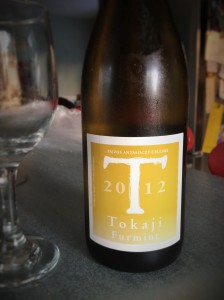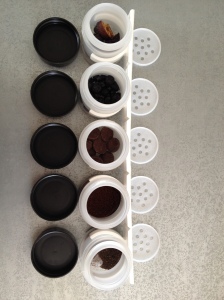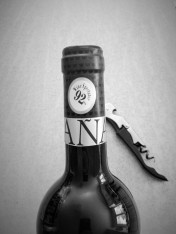So, there’s nothing like a renewal notice for your domain name to make you realize you’ve been neglecting your blog. I’ve just sat down and looked at how long it has been since writing anything, and it’s been a loooong time. Months in fact. And it wasn’t until I sat down today and opened up my homepage that I realized how much I’d missed it. It was like seeing a familiar, friendly face that I’d lost touch with, and I’m kicking myself for letting it get to the bottom of my list of things to do. That said, I have a pretty good reason for going AWOL. After 9 years of devoting my time to my kids as a stay-home-mom, I started looking to get back to work and I struck gold a lot quicker than I had been expecting. I was offered a job by a wine distributor, and have been working as an Imported Wine Specialist for them throughout New Jersey since September. It’s a fabulous job, and I’m loving every minute of it (of course I am, my days revolve around wine; talking about it, reading about it, teaching about it, presenting it, and of course drinking it… and I get paid for that!) But after such a long break, learning to juggle work and kids has taken a little time, and blogging just had to take a back seat. But, I’ve decided it’s time to try and add an extra line on my to-do list. I’m not aiming too high, I know I won’t get to sit down on a daily basis, and maybe not even weekly, but I’ll squeeze in some time whenever I can because I’ve missed it.
Now, full disclosure, chances are when I’m talking about a new wine I’ve tasted, it’ll almost certainly be found in the company’s portfolio. It makes sense, I’m regularly popping corks for work, and the choice and variety available is pretty huge. But I promise, I would never try and convince you a wine is good if I don’t like it. There are enough options for me to quite simply stay quiet about the ones I don’t like, and make sure I tell you all about the ones that I think are worth going looking for…
Talking of which, let me tell you about a particularly yummy little Pinot Noir that has been a pet favorite of mine over the last few months. Whenever I’m not sure which wine to present to an account, I grab a bottle of this and I’m pretty much guaranteed success.
 L’Etourneau, from Domaine Fouassier, is from the Sancerre region in France. Though most of us immediately think of gorgeous, elegant Sauvignon Blancs when we hear the word “Sancerre”, around 20% of the appellation’s production is actually red wine (all of which is Pinot Noir). Now, coming from the Loire valley, this is clearly a cooler climate Pinot Noir, and is old world in style. If you’re a lover of jammy, fruit-forward Pinot Noirs, then maybe this one isn’t for you. But if your kind of Pinot Noir is more along the lines of the Williamette Valley Pinots in Oregon and the world-famous French Burgundies, then this is definitely something worth hunting down to try. Just like classic Burgundy Pinot Noir, L’Etourneau is earthy and mineral, with fresh, ripe, red fruits, a little smokiness and great acidity. But it also has a wonderful pepperiness to it that you won’t find so prominently in a Burgundy Pinot, and I really like this added spicy warmth which lingers beautifully in your mouth. And as an added bonus, you can feel good about supporting this winery, which is 100 % organic and biodynamic. What’s not to like?
L’Etourneau, from Domaine Fouassier, is from the Sancerre region in France. Though most of us immediately think of gorgeous, elegant Sauvignon Blancs when we hear the word “Sancerre”, around 20% of the appellation’s production is actually red wine (all of which is Pinot Noir). Now, coming from the Loire valley, this is clearly a cooler climate Pinot Noir, and is old world in style. If you’re a lover of jammy, fruit-forward Pinot Noirs, then maybe this one isn’t for you. But if your kind of Pinot Noir is more along the lines of the Williamette Valley Pinots in Oregon and the world-famous French Burgundies, then this is definitely something worth hunting down to try. Just like classic Burgundy Pinot Noir, L’Etourneau is earthy and mineral, with fresh, ripe, red fruits, a little smokiness and great acidity. But it also has a wonderful pepperiness to it that you won’t find so prominently in a Burgundy Pinot, and I really like this added spicy warmth which lingers beautifully in your mouth. And as an added bonus, you can feel good about supporting this winery, which is 100 % organic and biodynamic. What’s not to like?
Expect to pay around $25 for a bottle of L’Etourneau at the wine store, and be prepared to search a little. It’s a relatively new import, and isn’t yet widely available (though I hope to change that of course…)




 The wine itself is a “rosé de presse”, which according to Chateau Maris, means it is being made the proper way! The two principal methods in rosé wine-making are the presse method and the saignée method, both of which use red grape varieties. The saignée method involves running off some of the “mout” (or juice) in a red wine fermentation vat (often around 10% of the overall volume). This allows the wine maker to produce a more concentrated and structured red wine, while at the same time giving him the possibility to allow the “saignée”, which will have had a certain amount of time in contact with the grape skins, to follow its own fermentation and produce a fairly structured and deeper colored rosé wine. In contrast, the “vin de presse” method used in the production of the Old School wine involves pressing the grapes to release the juice that will be fermented, and then quickly separating it away from the skins so that there will be minimal color and tannin extraction. This leads to much paler, salmon colored wines that are light, fresh and with good acidity.
The wine itself is a “rosé de presse”, which according to Chateau Maris, means it is being made the proper way! The two principal methods in rosé wine-making are the presse method and the saignée method, both of which use red grape varieties. The saignée method involves running off some of the “mout” (or juice) in a red wine fermentation vat (often around 10% of the overall volume). This allows the wine maker to produce a more concentrated and structured red wine, while at the same time giving him the possibility to allow the “saignée”, which will have had a certain amount of time in contact with the grape skins, to follow its own fermentation and produce a fairly structured and deeper colored rosé wine. In contrast, the “vin de presse” method used in the production of the Old School wine involves pressing the grapes to release the juice that will be fermented, and then quickly separating it away from the skins so that there will be minimal color and tannin extraction. This leads to much paler, salmon colored wines that are light, fresh and with good acidity. So, my 10 little pots turned up on my doorstep, and I kind of felt like a kid again as I excitedly opened the package, checked they were what I was looking for, and starting hunting around for items in my kitchen and garden that I could easily and quickly use.
So, my 10 little pots turned up on my doorstep, and I kind of felt like a kid again as I excitedly opened the package, checked they were what I was looking for, and starting hunting around for items in my kitchen and garden that I could easily and quickly use.


